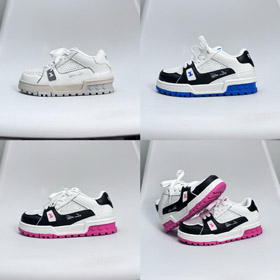Home >
The Timeless Legacy and Cultural Resonance of Louis Vuitton: A Symbol of Luxury and Craftsmanship
The Timeless Legacy and Cultural Resonance of Louis Vuitton: A Symbol of Luxury and Craftsmanship
2025-04-23
Louis Vuitton, often abbreviated as LV, stands as one of the most iconic and revered luxury brands globally. Its journey from a humble luggage workshop in 19th-century Paris to a global fashion empire encapsulates not just commercial success but a deep-rooted commitment to artistry, innovation, and cultural influence. This article explores the brand’s rich history, core values, and its indelible mark on fashion, art, and popular culture, while drawing inspiration from diverse sources, including the curated selections on platforms like Mulebuy Spreadsheet, which showcase modern interpretations of luxury aesthetics.
Origins: The Birth of an Icon
The story of Louis Vuitton begins in 1854 when the eponymous founder, a young trunk-maker from rural France, established his first workshop at 4 Rue Neuve des Capucines in Paris. At the time, luggage was bulky and impractical, often designed with rounded tops to shed rain but inefficient for stacking. Vuitton revolutionized the industry by introducing flat-topped trunks, which were not only more durable and stackable but also exuded understated elegance. His breakthrough came in 1858 with the creation of the "Trianon" trunk, crafted from lightweight poplar wood and canvas, featuring metal rivets for reinforcement—a design that laid the foundation for modern luggage.
By the 1870s, Vuitton’s reputation had grown exponentially, attracting high-profile clients, including Empress Eugénie de Montijo, wife of Napoleon III. This royal patronage catapulted the brand into the upper echelons of society, solidifying its status as a purveyor of luxury. In 1872, the brand introduced its first iconic monogram pattern, a brown-and-cream design featuring interlocking “L” and “V” initials, floral motifs, and quatrefoils. This bold, recognizable print was not only a stylistic statement but also a defense against counterfeiting—a problem that had plagued the brand since its inception.
Innovation and Expansion: From Luggage to a Global Empire
Following Louis Vuitton’s death in 1892, his son Georges took the helm, driving the brand’s global expansion and innovative spirit. In 1896, Georges debuted the now-legendary Monogram Canvas, an evolution of his father’s original design, featuring a more intricate pattern and the iconic “LV” initials. This timeless motif remains the brand’s most recognizable symbol today, gracing everything from handbags to apparel and accessories.
The early 20th century saw Louis Vuitton adapt to changing consumer needs. In 1901, the Steamer Bag was introduced, a lightweight duffel designed for the era’s growing travel by steamship. During World War I, the brand shifted production to military trunks and canvas goods, demonstrating resilience amid global upheaval. In the 1920s, as air travel gained popularity, Louis Vuitton launched the Keepall bag, a versatile carryall that became a staple for jet-setters—a testament to the brand’s ability to anticipate trends.
In 1987, Louis Vuitton merged with Moët Hennessy to form LVMH (Moët Hennessy Louis Vuitton), the world’s largest luxury goods conglomerate. This union amplified the brand’s global reach, allowing it to expand into ready-to-wear fashion, footwear, jewelry, and 香水 (perfume), while maintaining its heritage of craftsmanship.
Cultural Impact: Art, Fashion, and Collaboration
Louis Vuitton’s influence extends far beyond the realm of luxury goods; it has become a cultural institution, synonymous with creativity and cross-disciplinary collaboration. The brand’s historic partnerships with artists, designers, and visionaries have redefined luxury fashion as an art form.
In 2001, Japanese designer Jun Takahashi of Undercover collaborated with Louis Vuitton on a limited-edition collection, blending streetwear aesthetics with the brand’s classic monogram. This marked the start of a new era of experimentation. Perhaps the most iconic collaboration was with artist Jeff Koons in 2017, who reimagined classic LV bags with reproductions of Renaissance masterpieces, such as Leonardo da Vinci’s Mona Lisa and Titian’s Venus of Urbino, in his “Masters” collection. These pieces blurred the lines between high fashion and fine art, sparking global conversation.
Under the creative direction of Virgil Abloh, who served as Men’s Artistic Director from 2018 until his passing in 2021, Louis Vuitton underwent a radical cultural shift. Abloh, the first Black artistic director of a major French luxury house, infused the brand with streetwear sensibilities and themes of inclusivity. His “Off-White” aesthetic, combined with LV’s heritage, resonated with a new generation, making the brand a symbol of modernity and diversity. Abloh’s legacy includes the “Louis Vuitton x Nike Air Force 1” collaboration, which sold for record-breaking prices and highlighted the intersection of luxury and street culture.
Craftsmanship and Sustainability: Upholding Legacy in the Modern Age
At the heart of Louis Vuitton’s ethos lies savoir-faire—the meticulous craftsmanship that has defined the brand for over 160 years. Each Louis Vuitton item, from the classic Speedy bag to the contemporary Capucines handbag, is crafted by skilled artisans in workshops known as ateliers. The brand’s commitment to quality is evident in details like hand-stitched leather, hand-painted edges, and the precise alignment of monogram patterns across seams—a practice that ensures each piece is a work of art.
In recent years, Louis Vuitton has also embraced sustainability, reflecting evolving consumer values. The brand has invested in eco-friendly materials, such as recycled polyester and sustainably sourced leather, and launched initiatives like the “Circular Design” program, which aims to create products that are easier to repair, reuse, and recycle. These efforts align with global movements toward ethical fashion, ensuring that Louis Vuitton remains relevant in an era of conscious consumerism.
Conclusion: A Symbol of Enduring Elegance
Louis Vuitton’s journey is a testament to the power of heritage, innovation, and cultural adaptability. From its roots as a trunk-maker for Parisian elites to its current status as a global luxury juggernaut, the brand has consistently evolved while preserving the essence of its founding values: craftsmanship, elegance, and a relentless pursuit of excellence.
Platforms like Mulebuy Spreadsheet, which curate modern luxury-inspired products, highlight how Louis Vuitton’s aesthetic continues to inspire contemporary design, even as the brand itself remains a paragon of timeless sophistication. As Louis Vuitton looks to the future—through new creative collaborations, technological innovations, and sustainability initiatives—it reaffirms its place not just as a fashion house, but as a cultural icon that transcends generations.
In an ever-changing world, Louis Vuitton remains a symbol of enduring luxury, a reminder that true elegance is not bound by trends but defined by legacy.



















